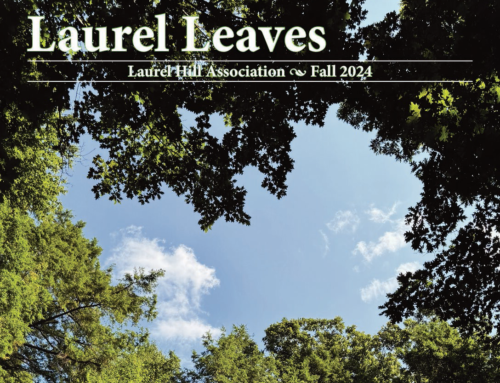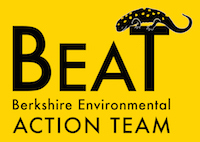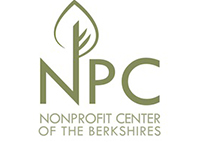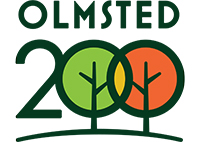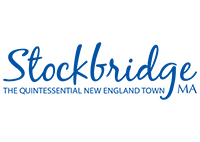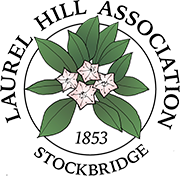An Interview with Pat Flinn
The institutional history of the Laurel Hill Association
by Michael Cobb
Pat Flinn moved to Stockbridge with her parents in 1959 when she was 15 years old. She graduated from Williams High School and earned her BA from Randolph-Macon Woman’s College. Pat has been on the board of the Laurel Hill Association for 40 years, the last 36 as Recording Secretary. Her home on Park Street abuts Laurel Hill Park, and is down the street from the Mary Flynn, Ice Glen, and Laura’s Tower trails. Pat grew up surrounded by the natural and historical setting of Laurel Hill. The keeper of deep knowledge, Pat is known as the institutional history of the Laurel Hill Association.
Listen to the complete interview with Pat Flinn
MC: What’s your connection to Stockbridge and the Berkshires?
PF: I came here with my parents when my dad was transferred here from Ohio with the Mead Paper Corporation. To paraphrase Loug Gehrig, I feel like the luckiest person in the world to have been brought here and to live in Stockbridge, which has been a blessing. I came here when I was 15 and a half, went to Williams High School, went to college, came back here, worked for Berkshire Life Insurance my entire career, and took early retirement at 60 in 2003. So that’s how I came to be here.
MC: How did you begin working for LHA?
PF: I moved to Park Street, abutting Laurel Hill Park, in 1979. In 1982 I noticed that half of the trail head sign at the Goodrich Memorial footbridge had broken away. So, I found out who the president of Laurel Hill was at the time, who was Lillian Bender. I knocked on her door and told her about the sign. She told me that board member Sue Burke’s husband had been transferred to Ohio. She asked me if I’d be interested in filling the board vacancy. I said sure and came on the board in September of 1982.
I became secretary in 1986 when Susan Kleinwald, the former secretary, moved to Great Barrington, because in those days you had to be a Stockbridge resident to be on the board. I have served in that capacity until now.
As of September of this year it will have been 40 years. To paraphrase what they say about Queen Elizabeth and how many US presidents she’s spanned, I’ve spanned 14 Laurel Hill presidents. Now I’m basically the institutional history, and I do like the historical aspects of Laurel Hill.
I just recently decided that I wanted to fulfill my longtime wish of collecting pictures of all the LHA presidents. I’m down to only two I can’t find. One is Herbert C. Lakin (1945-1947) and the other is William E. Williams (1966). So, that’s the story of my association with Laurel Hill.
Photo by Lionel Delevingne
“Visual Tour of Laurel Hill Park” presentation at the Library in 2017.
MC: It’s interesting that there’s been a back and forth connection with Ohio.
PF: Well, actually Sue Burke’s husband Clay Burke assumed the position that my dad had with the company. There were a couple of others in between. They all worked for Mead Paper, which is headquartered in Ohio.
MC: Is that connected to the old paper mill?
PF: Yes, the old Hurlbut Paper Mill in South Lee. The mill had been previously owned by a private family, the Sitzers. Dad came in to be president for Ed Sitzer, who had agreed to stay on for a year after Mead purchased Hurlbut. In that time dad learned the ropes and took over when Mr.Sitzer retired. So that’s basically how I got here.
MC: What was your initial role and how has that changed?
PF: In 1982 when I first came on the board, I was just a normal trustee. In 1986 I became secretary and have continued in that role. At this point I’m basically institutional history, and I really like that historical aspect of Laurel Hill, how the organization came to be, how the properties have been acquired, and things like that.
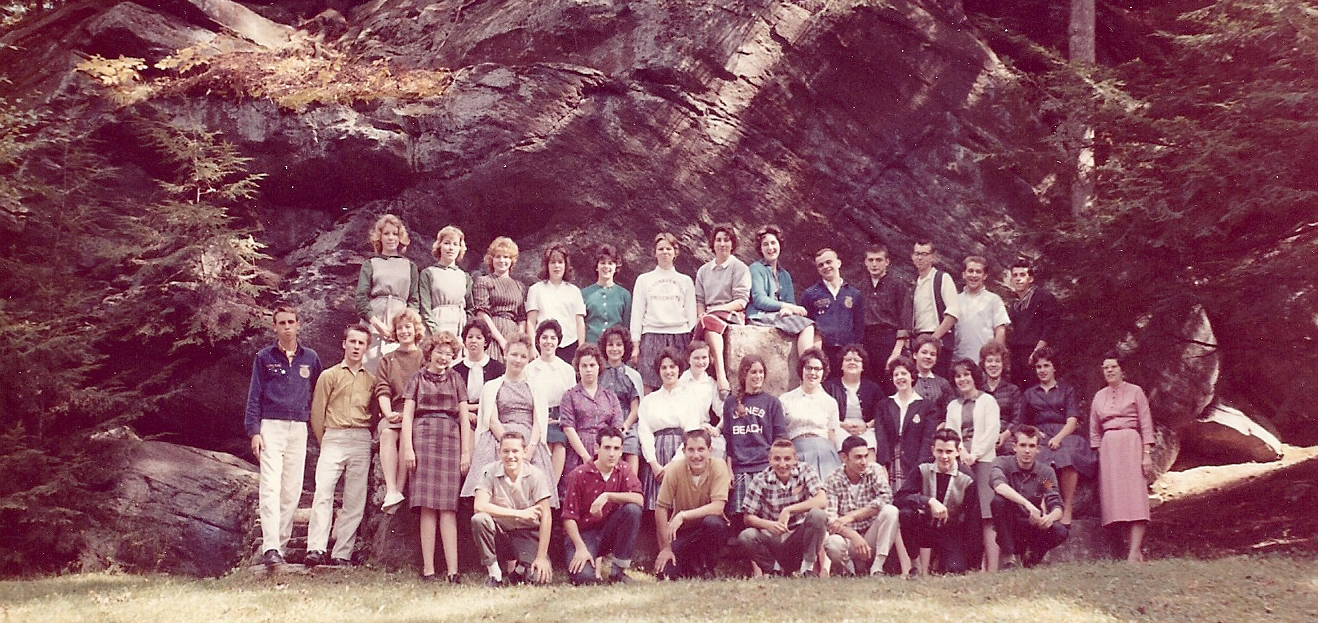
Pat’s 1962 Williams High School senior class picture at the Rostrum.
(Pat’s in the second row, which is mixed with some standing and some sitting on the wall.)
MC: Who have been some of the key board members over the years?
PF: Of course Mary Flynn was a driving force with Laurel Hill. She was the first woman president of Laurel Hill. It took that many years. Her first tenure was in the 1970s. She kept the flame really burning and was an adamant supporter of the organization. Other people who made impressions on me were, number one Jeff Parsons, who was second chair at the SALT II talks in Sweden for the United States. He made a comment in one of the meetings that has stuck with me ever since, and that is that the Laurel Hill Association is for the whole town of Stockbridge, not just the village center, but for the whole town including Glendale and Interlaken, and not to forget that. And I’ve always held that as one of the mantras for the organization.
Another person was Edgar Taft. He was instrumental in supervising the inspection and repainting of the Goodrich Memorial Bridge in the early 1990’s. There was a humorous incident…when it had been painted, he declared that it was a “lovely shade of mud.”
President Rush Taggart was not necessarily good at holding meetings, but he spent literally hours and days and weeks at the registry researching the deeds on all of the Laurel Hill properties and did a wonderful writeup of the properties up to that date.
Helen Pigott, who was an institution in Stockbridge, was also on the board. And Doug Goudey, who is now head of real estate for Wheeler and Taylor, was on the board for many years as treasurer, and contributed to the property handling and finances for Laurel Hill. So those are some of the people that stand out in my memory.
MC: Some of these names I recognize as trail names.
PF: Yes, and some of the benches. There’s an Edgar Taft bench and a Mary Flynn bench.
MC: What are the major aspects of the Laurel Hill Association?
PF: A couple of years back we held a little survey and asked people for one word that would describe Laurel Hill. We got two basic responses, one was “flowers”, because of the flowers that we plant in town in the summer. The other one was “trails”. So those, in the eyes of the public, are the things that they see and relate to for Laurel Hill. And that’s in direct response to the fact that we own close to 500 acres in the town of Stockbridge and those properties are all open to the public, with the exception of one.
The property acquisitions that we’ve had pretty much align with the centuries. In the 1800s were startup properties. Our first acquisition was Laurel Hill Park itself, then Railroad Station Park, and Goodrich Park, which is the parking and trailhead at the Goodrich Memorial Bridge. Mary Hopkins Goodrich founded the organization and called everybody in town to help clean up the town.
There was no municipal government as we think of it today at that time in 1853. The sidewalks were pretty much non-existent, the roads were horrible, there weren’t many trees, cows were roaming everywhere in the cemetery defecating everywhere, and brambles abounded. So she posted notices for people to meet on Laurel Hill and determine what could be done to help better the town and improve it. That’s when the Laurel Hill Association was born.
Over the years, it was a community based organization, in fact the first community-based improvement association in the United States. Over the years volunteers contributed to the improvement of the town, and over time municipal governments came into existence and took over some of the things that Laurel Hill initiated like trash clean up, lighting in town, improving sidewalks and streets, etc.
The next set of properties that we acquired in the 1900s were what I like to call legacy properties, which included the golf course properties, everything you see going across Main Street is Laurel Hill owned, The Sedwick Reservation, which has Laura’s Tower and now the Mary Flynn Trail, and Upper and Lower Bowker’s Woods, which were a gift of R.R. Bowker, who was one of the co-founders of the American Library Association. And Roeder Park over at the junction of 183 and the Glendale Middle Road, and the Rockwell Museum Grant, and Shamrock Woods, given by Mary Flynn, who always wanted to see those two acres across from her house on Shamrock Street green. She didn’t want it to be developed in any way.
Then in the 2000s the concentration was on protecting the entrances to town. The late Peter A.A. Berle, who was a past president of the American Audubon Society, approached Laurel Hill. I believe he was the president of the Stockbridge Land Trust at that time. He wanted to preserve the entrances to town and that’s when the two organizations went together 50/50 to purchase what is now the Chestnut Preserve between Route 7 south and the wetlands. We also collaborated on a 50/50 purchase of the Four Corners property and on the West Dale Preserve, which is part of the old Loveless property, from West Dale Road to the ridge and over to route 102.
Those three centuries of acquisitions divide out fairly nicely into those three groups of property purchases. Some of those properties have over the years been dormant from the standpoint that we haven’t done a lot with them. One of my Wish List items is to make those properties more accessible. One is Upper Bowker’s Woods which has Cinderella’s Pond across from the Rockwell Museum and another is a hidden gem that is the Pagenstecher Mill in Interlaken across from Train Hill Road and is historically significant in that it is the first pulp paper mill in the US. We’re just finishing a major restoration project for Laurel Hill Park, which is wonderful. We’ve removed an amazing amount of overgrowth that was blocking the wonderful soaring rocks and so people can enjoy these places. One of the current projects is to put property signs on those properties open to the public and have trails that are easily accessible. We’ve put in five signs in the last year and an interpretative sign in Laurel Hill Park, and more will be put in as we go along.
MC: Does making properties more accessible mean making trails where there are none?
PF: Yes, for Upper Bowker’s Woods we have laid out a short trail that will take you to the bench near Cinderella’s Pond and reopening the old logging road into that property will be an ideal spot for a nice hiking trail through the woods. That property is all flat and so will be handicap accessible.
MC: Who does the work?
PF: Sometimes we have volunteers help us, like every year before Laurel Hill Day, which we hold every year in August, volunteers help clearing the trails, raking, cleaning up. At times we’ve had the Greenagers doing trail work. Putting in things like parking in Lower Bowker’s Woods; we’ll be putting parking in Upper Bowker’s Woods. That gets hired out to professionals to do that kind of work.
MC: How has the Laurel Hill Association evolved over the years and how is it moving forward?
PF: In the beginning of course it was a totally community volunteer organization. It has continued in that aspect but one of the current challenges is that many of the residents in town did not grow up here. Over the years more and more nonprofits have been established and are taking the resources, so we now have to share funding with other organizations. The residents who did not grow up here, did not go to school here at the Plain School and did not go up to play at Laurel Hill Park. The new residents are not aware of Laurel Hill. One of the current challenges is to get our name out there and compete with the other organizations in town. So after 167 years, we decided we needed to put in property signs on the more used properties and make people aware that we exist and who we are. So for the outreach in town in the last few years, we’ve held a couple of Friends’ events at the Taggart House to let people know that we exist. We hope they will help and support us. That’s been one of our challenges going forward. We hope to be a conduit for information so that we can develop some awareness and educational programs to get people to our properties to make them aware of some of the current issues that are coming along such as the protection of some of the trees that are undergoing stress from disease and promoting information about these projects and situations so that we can help the public be more aware of what’s going on and aware of Laurel Hill.
MC: So a lot of those are outreach and communications?
PF: Yes, outreach and communications and education. Not taking sides but fostering information gathering and dissemination.
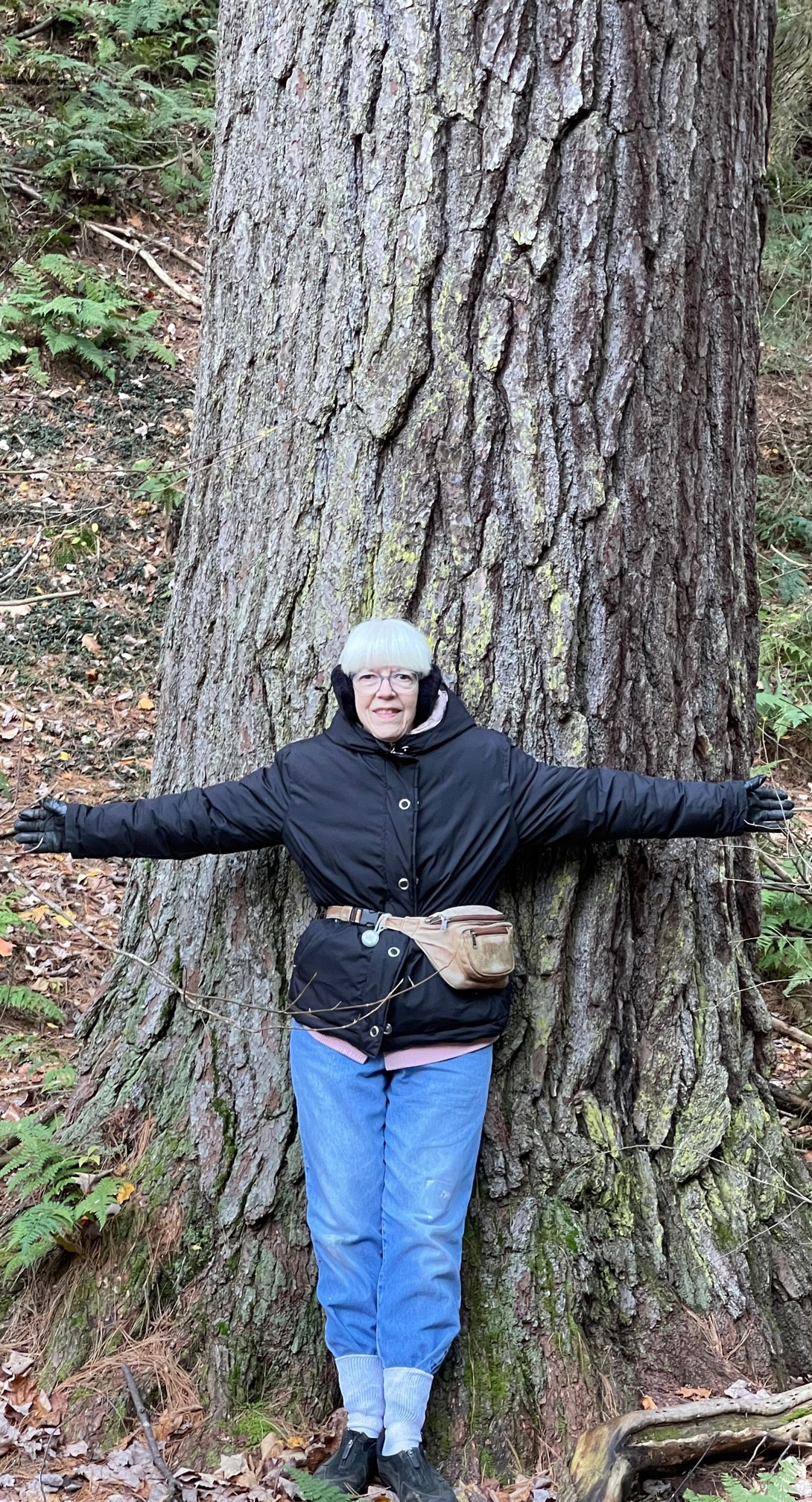
Photo by Jim Schantz
Pat and her favorite Stockbridge tree…the magnificent white pine sentinel at the southern entrance to Ice Glen, fall 2021.
MC: I know there’d been plans for an educational series, to possibly include some classes. Is anything happening with that?
PF: We’ve had some things like photography classes on the trails, so some of those things are in the works. Over the years we’ve put more emphasis on the educational aspect and getting information out to people and encouraging them via the properties to learn more, such as some of the Heritage Walks that I’ve done for LHA and the Mary Flynn Trail that will disseminate a lot of historical aspects of these trails. The Mary Flynn Trail in particular was built on the bed of the old Berkshire Street Railway. Interestingly enough, the inventor of the first practical electric trolley was Stephen Dudley Field, who lived right behind St.Paul’s Church. He was an inventor, though not necessarily a developer of the inventions. When the first trolley was to be instituted in Stockbridge and slated to go down Main Street, he was one of the leading opponents. He helped establish easements on the south side of the river to put the trolley there and then cross the river and come down what is now Park Street. The little building across Park Street from the gas station is the old trolley stop. Then it went back across the river and into Glendale. Stockbridge was the only town on the Berkshire Street Railway system that did not have a trolley going down the main street. There’s a lot of irony there.
I have to add another humorous incident. When Arthur Schwartz was president of Laurel Hill, the insurance company that we were working with wanted to inspect Laura’s Tower. The inspectors hadn’t a clue where it was. They arrived in suits and wingtip shoes and had to hike up a 600 foot ascent through the woods, which must’ve been quite an experience for someone dressed in wingtip shoes. They were totally unprepared.
MC: But stylish.
PF: Yes, stylish.
MC: What else does LHA want to achieve in the area?
PF: I think we will need to continue to be proactive instead of reactive. Keeping that in mind, in the last few years we have established goals for the organization, which has been a big step for us. We also want to continue to develop the committee system to be a driving force for LHA, with that we need to continue to do outreach and encourage use and promotion of our trails with environmentally sound practices going forward.
MC: How can people find out more about LHA and how can they get involved?
PF: A good place to start is our website which is www.laurelhillassociation.org. There you can see some properties and historical things like the last Laurel Hill Day observance writeup, and about the trustees themselves. There you can get involved, sign up to be a volunteer, and donate to the organization. As I said before, we have to compete with organizations that didn’t exist when Laurel Hill was first here. Support would be very helpful. We hope that everybody will enjoy the trails, get to know LHA, and find out more about us on the website. We also send out newsletters and e-blasts which have a lot of information about what we’re doing and ways that people can get involved.
MC: Thank you, Pat!
PF: Thank you.
